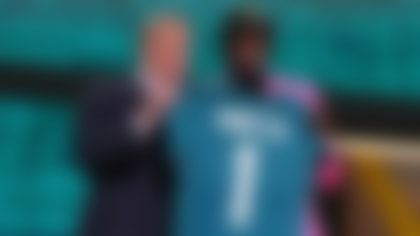Which Nnamdi Asomugha will show up in San Francisco?
That's the question scouts around the NFL are mulling over, with the three-time Pro Bowler agreeing to a one-year deal (worth up to $3 million) with the two-time reigning NFC West champions.
A few years ago, the addition of Asomugha to the 49ers' lineup seemingly would have tipped the balance of power in the NFC, based on his reputation and performance as a premier cover corner in football. But after a pair of disappointing seasons for the Philadelphia Eagles, Asomugha's signing is a mere blip on the radar. Critics believe the 31-year-old's better days are behind him, thinking he's only capable of making a minimal contribution to a team set to make another run at the Lombardi Trophy.
Given some time to study Asomugha's game and consider the possibilities in San Francisco, here are my answers to three key questions about the veteran cornerback:
What happened to Asomugha in Philadelphia?
When a free-agent signing doesn't work out in the NFL, there is often a pretty simple explanation: an improper fit between player and scheme. In Philadelphia, Asomugha's game didn't mesh well with the zone-heavy concepts preferred by defensive coordinator Juan Castillo.
The Eagles spent most of 2011 playing an assortment of two- and three-deep zones with cornerbacks positioned away from the line of scrimmage. Asomugha was instructed to play with vision on the receiver and quarterback, and make plays on the ball through anticipation and route recognition. The Eagles also attempted to move Asomugha around to capitalize on his skills as a lockdown corner. However, he never looked comfortable in his new role, playing in a scheme that forced him to rely solely on polished footwork and technique against shifty receivers in space.
Last season, the Eagles tweaked their defensive scheme to better accommodate Asomugha's talents as a bump-and-run corner, but the 10-year veteran continued to struggle on the perimeter. He repeatedly lost leverage on receivers early in routes and lacked the recovery speed to make up for his technical mistakes. Asomugha's loss of explosiveness and burst was particularly exposed when he faced elite receivers throughout the season. In matchups against the likes of Victor Cruz, Julio Jones and Larry Fitzgerald, Asomugha was unable to hold his own without safety help over the top. (See: The video to your right.) Moreover, the constant barrage of throws in his direction appeared to shake his confidence and temper some of the aggressiveness that had been a trademark throughout the years.
As a member of the Oakland Raiders for his first eight NFL seasons, Asomugha earned notoriety with his tenacious skills in press coverage. Checking in at 6-foot-2, 210 pounds, he used his exceptional combination of length, athleticism and toughness to maul receivers in coverage. He would vary techniques between one- or two-hand quick jams and an assortment of shadow movements to knock receivers off their routes. With most wideouts unable to shake Asomugha in coverage, quarterbacks avoided throwing balls in his direction, essentially eliminating half of the field in the passing game. Now, part of quarterbacks' reluctance to throw to his side of the field was due to his preference for playing right cornerback, which is the weak side of most passing games. That said, he certainly played well enough during his tenure at Oakland to discourage throws in his area.
If the Eagles had demonstrated a willingness to adapt the scheme to Asomugha's talents, rather than plug him into a system that required a complete change in his game, he might have lived up to some of the lofty expectations that accompanied his arrival in Philly.
How does Asomugha fit into San Francisco's defense?
Brooks: Ten biggest player moves
From Alex Smith to Elvis Dumervil, Bucky Brooks breaks down the 10 most important player moves of the offseason. **More ...**
The insertion of Asomugha into the 49ers' lineup could be a terrific move for both parties. Vic Fangio's defense is built upon a variety of man coverage concepts that ideally suit Asomugha's talents. When I broke down the 49ers' defensive tape, I noticed the unit primarily played a heavy dose of Cover 1 Robber (man-free with a safety lurking in the middle) and 2-Man (two deep safeties with underneath defenders in tight man coverage). The cornerbacks routinely align in press coverage to take away easy short/intermediate throws outside of the numbers. Given the fact that San Francisco can generate pressure with only four rushers, defensive backs are free to aggressively jump routes in their area and make plays on the ball, knowing a safety or linebacker is going to assist them in coverage down the field. This results in a number of deflections and interceptions. For Asomugha, these tactics could help him regain the aggressiveness and swagger that made him a feared defender for most of his career.
With outside routes taken away by alignment and a help defender robbing in-breaking routes, Tom Brady forces a throw into traffic, resulting in a Carlos Rogers interception down the field.
The next screengrab displays San Francisco's 2-Man coverage during the NFC title game triumph over the Atlanta Falcons. The defensive backs are disguising their 2-man intentions by aligning 5 yards away from their assigned receivers:
After the snap, the defenders sit and wait for their receivers to run up the field before jumping into a trail position, anticipating short/intermediate routes. San Francisco CB Chris Culliver reads Roddy White's curl route and jumps in front for a crucial interception in the NFC Championship Game:
During the regular season in 2012, the 49ersranked fourth in pass defense (200.2 pass yards per game). But San Francisco struggled mightily against the aerial attack in the playoffs. Aaron Rodgers, Matt Ryan and Joe Flacco carved up the 49ers with pinpoint passes to big-bodied receivers on the perimeter. The inferior physical dimensions of San Francisco's corners were exposed in each of those matchups, particularly against Jones and Anquan Boldin. Given Asomugha's size, aggressiveness and skill, the 49ers now have a corner for those situations. While he has lost a step, Asomugha could give the 49ers' defense a major boost if he regains his swagger.
Can Asomugha become an elite corner again?
That's the million dollar question 49ers' officials certainly pondered when Asomugha became available on the open market. Just two years ago, the cover man was widely considered one of the premier players at his position. Although father time has started to catch up to him -- Asomugha turns 32 in July -- he didn't lose all of his skills and knowledge during the failed two-year stint in Philadelphia.
In fact, I believe Asomugha's disappointing tenure with the Eagles could help him become a better player with the 49ers. The experience should teach him the importance of playing to his strengths at all times, which is a difficult lesson for players to learn until they fail on a big stage. As a young player, Asomugha was able to rely solely on his size, speed and athleticism to blanket receivers on the perimeter. Now, he must lean on technique, footwork and experience in order to excel at an advanced age. Veteran players can play faster than their young counterparts by relying on savvy, guile and extensive film study -- anticipating plays before they happen. With better preparation and focus, he can make up for sudden physical deficiencies.
If I had to point to a player as a prime example for how Asomugha could evolve with the 49ers, I would cite his former teammate in Oakland: Charles Woodson. The eight-time Pro Bowler was considered washed up following a disappointing end to his time in Oakland, but he rejuvenated his career in Green Bay with diligent preparation and focus. He spent more time in the film room picking up the nuances of the game, and those tips allowed him to play much faster than anticipated. While Asomugha lacks Woodson's ball skills and playmaking ability, he his abilities as a press corner are very comparable. Asomugha can still be an effective player on the island.
Follow Bucky Brooks on Twitter @BuckyBrooks.












